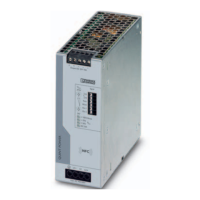
Do you have a question about the Phoenix Contact QUINT4-PS/3AC/24DC/10 and is the answer not in the manual?
| Brand | Phoenix Contact |
|---|---|
| Model | QUINT4-PS/3AC/24DC/10 |
| Category | Power Supply |
| Language | English |
SFB technology and power reserves.
Mains buffering and electrical immunity.
Comprehensive signaling and pre-configuration.
Lists various accessories for the power supply.
Details input voltage range, frequency, and current draw.
Specifies buffering time for power interruptions.
Defines the power supply's switch-on time.
Mentions surge protection components.
Details surge current limitation after 1ms.
Specifies AC input protection requirements.
Details insulation test voltages.
Specifies connection methods and conductor data.
Specifies the nominal DC output voltage.
Defines the adjustable output voltage range.
States the maximum continuous output current.
Details the sustained higher output current capability.
Describes the temporary higher output current.
Specifies the SFB current for tripping protection.
Confirms electronic short-circuit protection.
Confirms operation without a load.
Specifies the maximum output voltage ripple.
Notes possibility of parallel connection for redundancy.
Notes possibility of series connection for voltage increase.
Specifies connection methods and conductor data for output.
Explains LED indicators for output status.
Details configurable signal outputs.
Specifies the IP protection rating.
Provides physical dimensions of the unit.
Details power consumption in various modes.
Shows efficiency percentages at different loads.
Defines operating temperature range with derating.
Details altitude limits for operation.
Lists overvoltage categories for standards.
Lists relevant rail application standards.
Lists UL certifications.
Lists CSA certifications.
Covers conducted and radiated noise emission standards.
Details immunity requirements against various disturbances.
Specifies ESD immunity requirements.
Specifies RF field immunity requirements.
Specifies transient immunity requirements.
Specifies surge voltage immunity.
Specifies conducted interference immunity.
Specifies immunity to voltage dips.
Specifies ring wave immunity.
Specifies asymmetrical conducted disturbance immunity.
Specifies attenuated oscillating wave immunity.
Important pre-startup safety checks.
Warning about hazardous internal voltages.
Warning about potential hot surfaces.
Explains the dielectric strength testing process.
Guides end-user on performing tests.
Details procedures for performing HV testing.
Instructions for disconnecting surge arrester for testing.
Identifies and describes the main components of the power supply.
Explains symbols used in the block diagram.
Step-by-step guide for mounting the unit.
Step-by-step guide for removing the unit.
Information on mounting the DIN rail adapter at 90°.
Instructions for mounting the DIN rail adapter on the left side.
Details on using wall adapters for mounting.
Steps to mount the UWA 182/52 adapter.
Steps to mount the UWA 130 adapter.
How to secure connection wiring using cable binders.
Describes AC input connection and network configurations.
Details primary side protection requirements.
Explains output voltage adjustment.
Covers secondary side protection and fault behavior.
Lists different application areas for output curves.
Highlights benefits of each characteristic curve.
Lists available output characteristic curves.
Details the advanced U/I characteristic curve.
Explains the Smart HICCUP curve and its behavior.
Describes the FUSE MODE curve and its shutdown behavior.
Steps to configure via PC software using NFC adapter.
General procedure for power supply configuration.
How to configure using a mobile app via NFC.
Information on ordering pre-configured units.
Details sustained higher output current capability.
Explains temporary higher output current and recovery.
Table for recovery times at 40°C.
Table for recovery times at 60°C.
Example calculation for recovery time.
How SFB technology trips circuit breakers.
How SFB technology trips fuses.
Framework conditions for SFB configuration.
Specifies maximum cable lengths for SFB operation.
Max distance table for specific circuit breakers.
Max distance table for Siemens/ABB circuit breakers.
Max distance table for Cooper Bussmann fuses.
Identifies signaling elements and LEDs.
Details the floating signal contact function.
Explains digital signal outputs.
Explains analog signal output.
Shows default signal settings for various parameters.
Explains output voltage signaling.
Explains output current signaling.
Explains output power signaling.
Explains high temperature warning signaling.
Explains voltage limitation active signaling.
Explains input voltage OK signaling.
Explains phase monitoring signaling.
Explains the remote input function.
Details the function of front panel LED indicators.
Shows default signaling for U/I Advanced curves.
Shows default signaling for SMART HICCUP curves.
Shows default signaling for FUSE MODE curves.
Describes signaling behavior in SLEEP MODE.
Covers special immunity requirements for signal connections.
How to connect two units in series for higher voltage.
How to connect units in parallel for increased power or redundancy.
Details redundant operation for reliability.
Explains parallel connection for increased output power.
Explains output power reduction due to high ambient temperatures.
Discusses output power in 2AC operation.
Explains output power reduction due to installation height.
Details derating based on mounting orientation.
Derating curves for normal mounting.
Derating curves for 90° Z-axis mounting.
Derating curves for 180° Z-axis mounting.
Derating curves for 270° Z-axis mounting.
Derating curves for 90° X-axis mounting.
Derating curves for 270° X-axis mounting.
